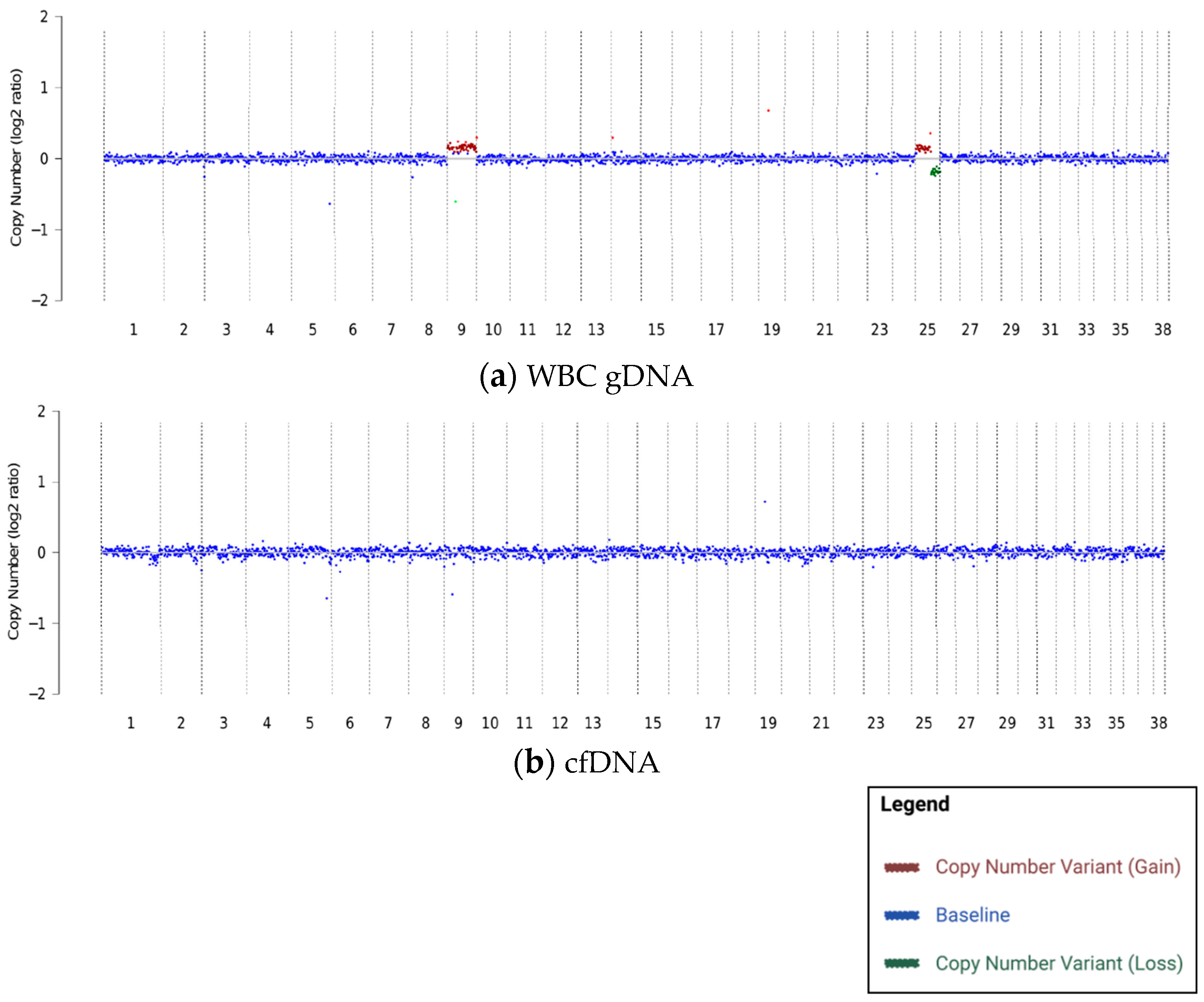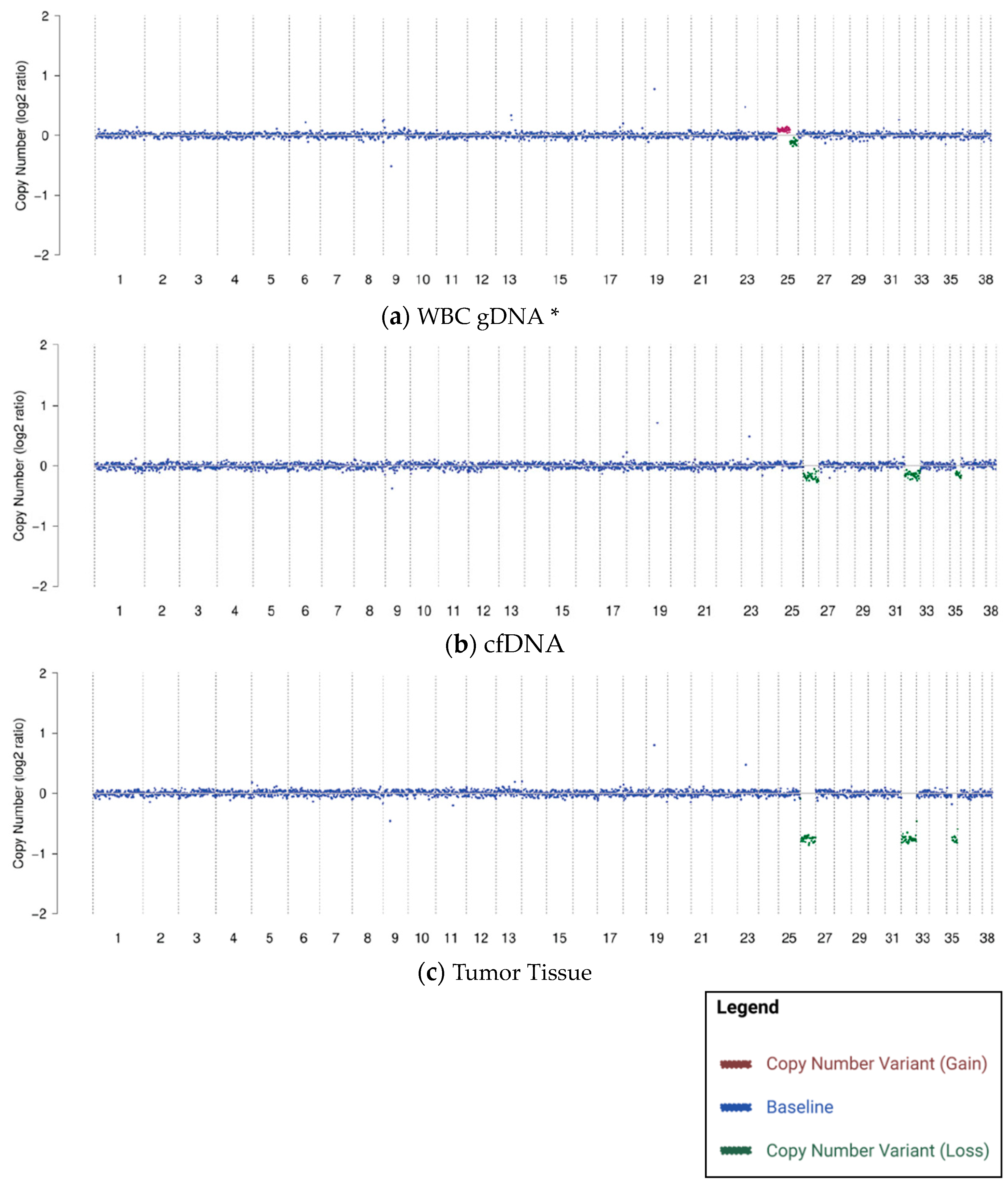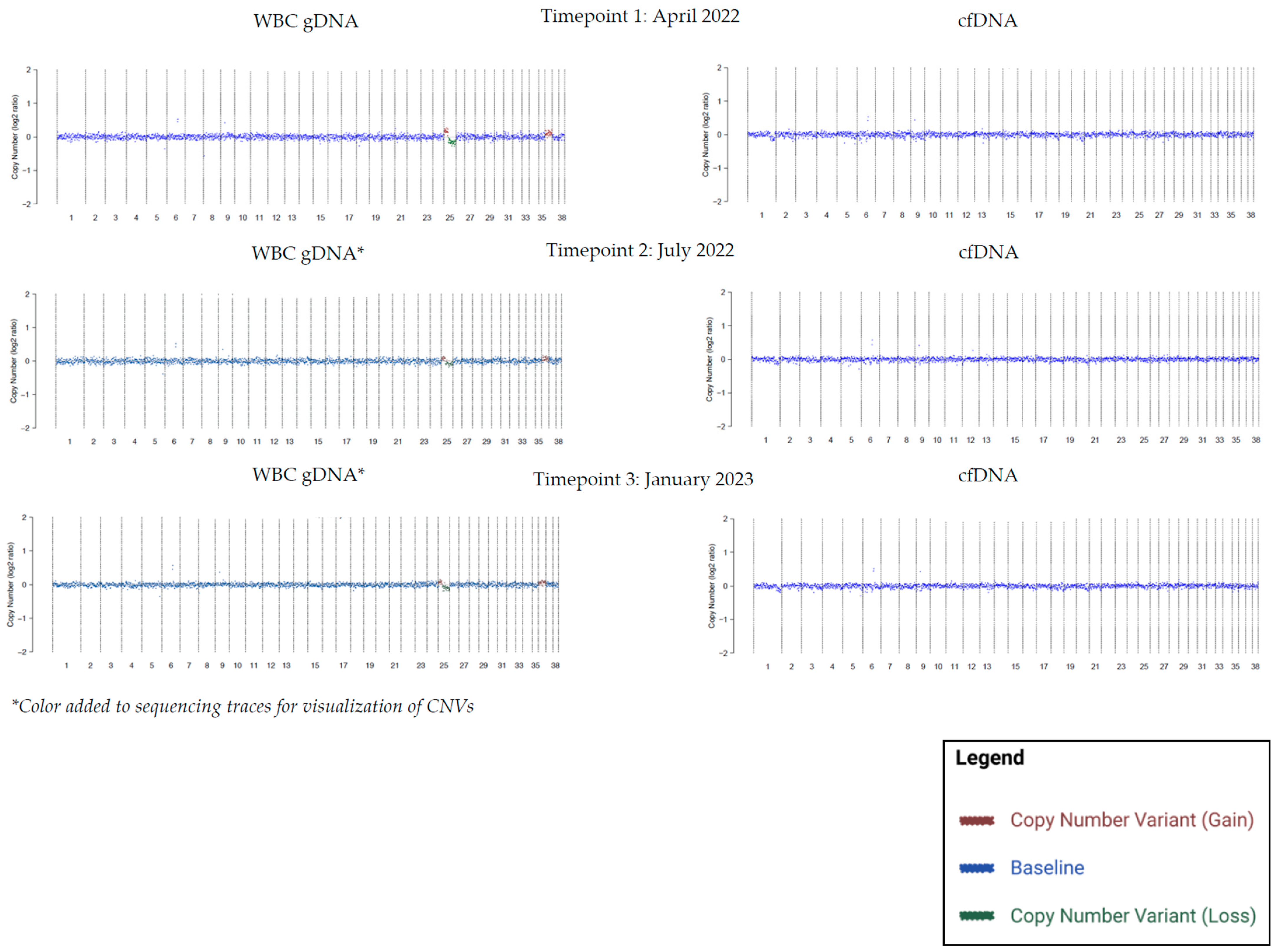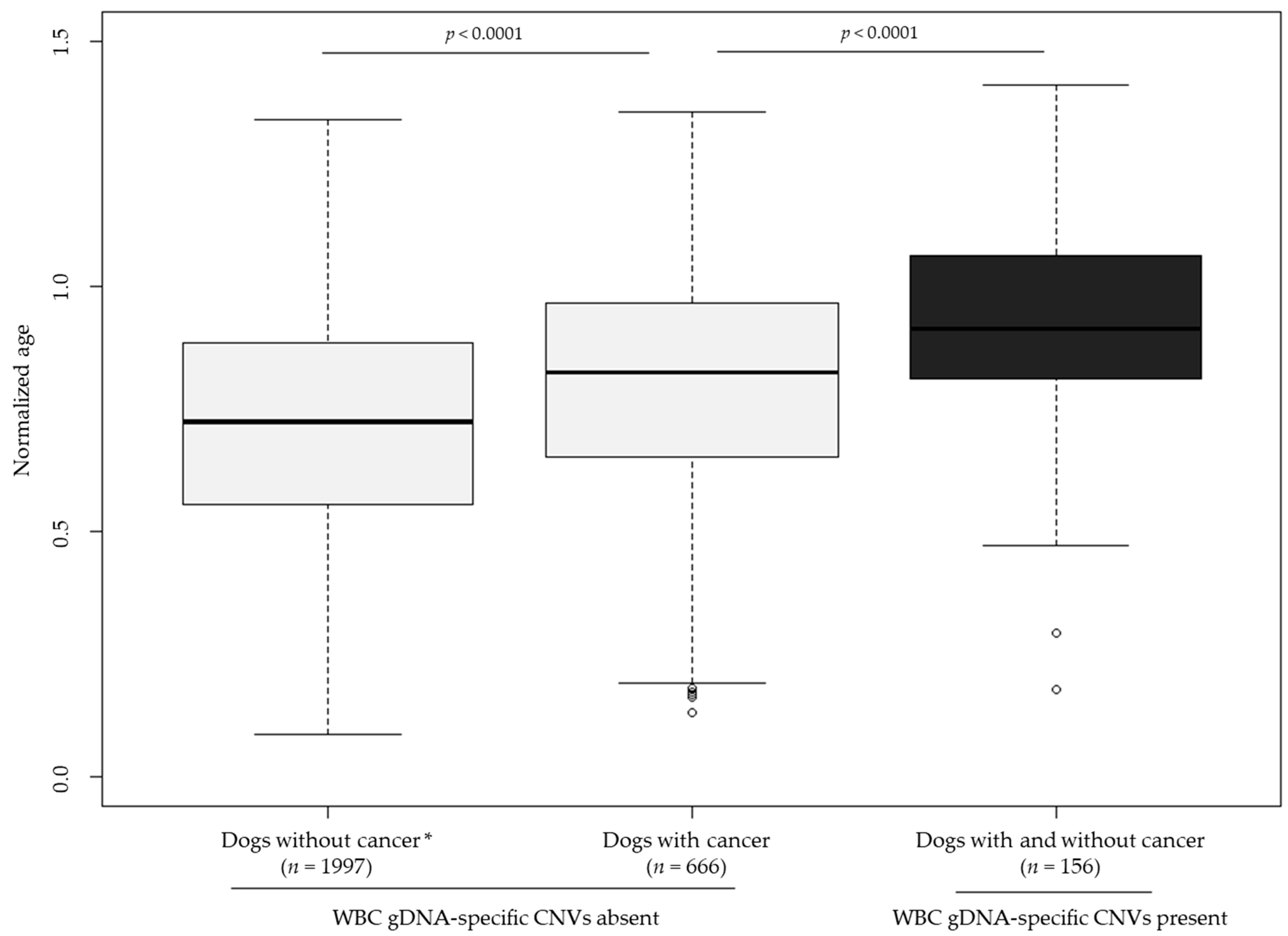Detection of Age-Related Somatic Alterations in Canine Blood Using Next-Generation Sequencing-Based Liquid Biopsy: An Analysis of over 4800 Dogs
Abstract
Simple Summary
Abstract
1. Introduction
2. Materials and Methods
3. Results
3.1. Population Characteristics
3.2. Dogs with WBC gDNA-Specific CNVs and Their Associated Clinical Status
3.3. WBC gDNA-Specific CNVs Not Present in Matched Tumor Tissue When Cancer Is Concurrently Present
3.4. WBC gDNA-Specific CNVs Persistent across Longitudinal Samples
3.5. WBC gDNA-Specific CNVs at Recurrent Locations in the Genome
3.6. WBC gDNA-Specific CNVs More Frequently Observed in Older Dogs
4. Discussion
5. Conclusions
Author Contributions
Funding
Institutional Review Board Statement
Informed Consent Statement
Data Availability Statement
Acknowledgments
Conflicts of Interest
References
- Jaiswal, S.; Ebert, B.L. Clonal Hematopoiesis in Human Aging and Disease. Science 2019, 366, eaan4673. [Google Scholar] [CrossRef] [PubMed]
- Jaiswal, S.; Fontanillas, P.; Flannick, J.; Manning, A.; Grauman, P.V.; Mar, B.G.; Lindsley, R.C.; Mermel, C.H.; Burtt, N.; Chavez, A.; et al. Age-Related Clonal Hematopoiesis Associated with Adverse Outcomes. N. Engl. J. Med. 2014, 371, 2488–2498. [Google Scholar] [CrossRef] [PubMed]
- Genovese, G.; Kähler, A.K.; Handsaker, R.E.; Lindberg, J.; Rose, S.A.; Bakhoum, S.F.; Chambert, K.; Mick, E.; Neale, B.M.; Fromer, M.; et al. Clonal Hematopoiesis and Blood-Cancer Risk Inferred from Blood DNA Sequence. N. Engl. J. Med. 2014, 371, 2477–2487. [Google Scholar] [CrossRef] [PubMed]
- Gao, T.; Ptashkin, R.; Bolton, K.L.; Sirenko, M.; Fong, C.; Spitzer, B.; Menghrajani, K.; Ossa, J.E.A.; Zhou, Y.; Bernard, E.; et al. Interplay between Chromosomal Alterations and Gene Mutations Shapes the Evolutionary Trajectory of Clonal Hematopoiesis. Nat. Commun. 2021, 12, 338. [Google Scholar] [CrossRef] [PubMed]
- Saiki, R.; Momozawa, Y.; Nannya, Y.; Nakagawa, M.M.; Ochi, Y.; Yoshizato, T.; Terao, C.; Kuroda, Y.; Shiraishi, Y.; Chiba, K.; et al. Combined Landscape of Single-Nucleotide Variants and Copy Number Alterations in Clonal Hematopoiesis. Nat. Med. 2021, 27, 1239–1249. [Google Scholar] [CrossRef]
- Grisham, J. MSK Opens New Clinic to Monitor People with a Genetic Risk for Developing Blood Cancer. Available online: https://www.mskcc.org/news/msk-opens-new-clinic-monitor-people-genetic-risk-developing-blood (accessed on 30 January 2023).
- Mayo Clinic Clonal Hematopoiesis Clinic Stratifies Risk for Patients with Cancer. Available online: https://www.mayoclinic.org/medical-professionals/cancer/news/clonal-hematopoiesis-clinic-stratifies-risk-for-patients-with-cancer/mac-20543180 (accessed on 30 January 2023).
- Cleveland Clinic New Clinic Tackles Mutations That Increase Risk of Blood Cancers and Heart Disease. Available online: https://consultqd.clevelandclinic.org/new-clinic-tackles-mutations-that-increase-risk-of-blood-cancers-and-heart-disease/ (accessed on 30 January 2023).
- Siteman Cancer Center ARCH Clinic. Available online: https://siteman.wustl.edu/treatment/cancer-types/myelodysplastic-syndromes/archclinic/ (accessed on 30 January 2023).
- Jaiswal, S.; Natarajan, P.; Silver, A.J.; Gibson, C.J.; Bick, A.G.; Shvartz, E.; McConkey, M.; Gupta, N.; Gabriel, S.; Ardissino, D.; et al. Clonal Hematopoiesis and Risk of Atherosclerotic Cardiovascular Disease. N. Engl. J. Med. 2017, 377, 111–121. [Google Scholar] [CrossRef] [PubMed]
- Mayerhofer, E.; Strecker, C.; Becker, H.; Georgakis, M.K.; Uddin, M.M.; Hoffmann, M.M.; Nadarajah, N.; Meggendorfer, M.; Haferlach, T.; Rosand, J.; et al. Prevalence and Therapeutic Implications of Clonal Hematopoiesis of Indeterminate Potential in Young Patients With Stroke. Stroke 2023, 54, 938–946. [Google Scholar] [CrossRef] [PubMed]
- Steensma, D.P.; Bolton, K.L. What to Tell Your Patient with Clonal Hematopoiesis and Why: Insights from 2 Specialized Clinics. Blood 2020, 136, 1623–1631. [Google Scholar] [CrossRef] [PubMed]
- Flory, A.; Kruglyak, K.M.; Tynan, J.A.; McLennan, L.M.; Rafalko, J.M.; Fiaux, P.C.; Hernandez, G.E.; Marass, F.; Nakashe, P.; Ruiz-Perez, C.A.; et al. Clinical Validation of a Next-Generation Sequencing-Based Multi-Cancer Early Detection “Liquid Biopsy” Blood Test in over 1000 Dogs Using an Independent Testing Set: The CANcer Detection in Dogs (CANDiD) Study. PLoS ONE 2022, 17, e0266623. [Google Scholar] [CrossRef] [PubMed]
- Kruglyak, K.M.; Chibuk, J.; McLennan, L.; Nakashe, P.; Hernandez, G.E.; Motalli-Pepio, R.; Fath, D.M.; Tynan, J.A.; Holtvoigt, L.E.; Chorny, I.; et al. Blood-Based Liquid Biopsy for Comprehensive Cancer Genomic Profiling Using Next-Generation Sequencing: An Emerging Paradigm for Non-Invasive Cancer Detection and Management in Dogs. Front. Vet. Sci. 2021, 8, 704835. [Google Scholar] [CrossRef] [PubMed]
- Beuchat, C. Lifespan in Dogs. Available online: https://www.instituteofcaninebiology.org/lifespan.html (accessed on 4 November 2022).
- Takahashi, K.; Wang, F.; Kantarjian, H.; Song, X.; Patel, K.; Neelapu, S.; Gumbs, C.; Little, L.; Tippen, S.; Thornton, R.; et al. Copy Number Alterations Detected as Clonal Hematopoiesis of Indeterminate Potential. Blood Adv. 2017, 1, 1031–1036. [Google Scholar] [CrossRef] [PubMed]
- Sebastian, K.; Özer, H.G.; Howard, C.; Chadsey, L.; Lozanski, A.; Doong, T.-J.; Orwick, S.; Lozanski, G.; Ma, W.; Kisseberth, W.C.; et al. Clonal Hematopoiesis of Indeterminate Potential in the Companion Dog. Leukemia 2022, 36, 1401–1403. [Google Scholar] [CrossRef] [PubMed]




| Clinical Cohort (n = 3595) N (%) | Research Cohort (n = 1275) N (%) | |
|---|---|---|
| Cancer status | ||
| Cancer suspected | 962 (26.8%) | - |
| Cancer not suspected | 2399 (66.7%) | - |
| Cancer suspicion not provided | 234 (6.5%) | - |
| Cancer-diagnosed | - | 569 (44.6%) |
| Presumably cancer-free | - | 706 (55.4%) |
| Sex | ||
| Male | 1797 (50.0%) | 665 (52.2%) |
| Neutered | 1581 | 572 |
| Intact | 204 | 92 |
| Not provided | 12 | 1 |
| Female | 1750 (48.7%) | 610 (47.8%) |
| Spayed | 1608 | 553 |
| Intact | 96 | 56 |
| Not provided | 46 | 1 |
| Sex not provided | 48 (1.3%) | 0 (0%) |
| Age (years) | ||
| Mean (SD) | 9.1 (3.1) | 7.2 (3.7) |
| Weight (kg) | ||
| Mean (SD) | 25.8 (13.5) * | 28.3 (12.0) |
| Breed classification | ||
| Purebred | 2198 (61.1%) | 630 (49.4%) |
| Mixed-breed or unknown | 1397 (38.9%) | 645 (50.6%) |
| Clinical Cohort (n = 3595) N; % [95% CI] | Research Cohort * (n = 1275) N; % [95% CI] | |
|---|---|---|
| gDNA-specific CNVs present without concurrent cfDNA CNVs | 107; 3.0 [2.5, 3.6] | 19; 1.5 [0.9, 2.4] |
| Cancer evaluation performed | 28 | 14 |
| Cancer | 9 | 14 |
| No cancer | 19 | 0 |
| No additional cancer evaluation following | 79 | 5 |
| liquid biopsy | ||
| gDNA-specific CNVs present with concurrent cfDNA CNVs | 22; 0.6 [0.4, 0.9] | 16; 1.3 [0.7, 2.1] |
| Cancer evaluation performed | 11 | 15 |
| Cancer | 11 | 15 |
| No cancer | 0 | 0 |
| No additional cancer evaluation following | 11 | 1 |
| liquid biopsy | ||
| gDNA-specific CNVs absent | 3466; 96.4 [95.8, 97.0] | 1240; 97.3 [96.2, 98.0] |
| Cancer evaluation performed | 422 | 549 |
| Cancer | 124 | 542 |
| No cancer | 298 | 7 |
| No additional cancer evaluation following | 3044 | 691 |
| liquid biopsy |
| Chromosome | Gain/Loss | Number of Dogs with This Finding * | % of Dogs with WBC gDNA-Specific CNVs with This Finding * % [95% CI] |
|---|---|---|---|
| 25 | Loss | 46 | 28.1 [21.7, 35.4] |
| 25 | Gain | 39 | 23.8 [17.6, 31.2] |
| 16 | Loss | 22 | 13.4 [8.8, 19.8] |
| 9 | Gain | 21 | 12.8 [8.3, 19.1] |
| 14 | Gain | 18 | 11.0 [6.8, 17.0] |
| 13 | Gain | 14 | 8.5 [4.9, 14.2] |
| 8 | Loss | 13 | 7.9 [4.5, 13.5] |
| 36 | Gain | 10 | 6.1 [3.1, 11.2] |
Disclaimer/Publisher’s Note: The statements, opinions and data contained in all publications are solely those of the individual author(s) and contributor(s) and not of MDPI and/or the editor(s). MDPI and/or the editor(s) disclaim responsibility for any injury to people or property resulting from any ideas, methods, instructions or products referred to in the content. |
© 2023 by the authors. Licensee MDPI, Basel, Switzerland. This article is an open access article distributed under the terms and conditions of the Creative Commons Attribution (CC BY) license (https://creativecommons.org/licenses/by/4.0/).
Share and Cite
Kruglyak, K.M.; O’Kell, A.L.; Cohen, T.A.; Marshall, M.A.; Ruiz-Perez, C.A.; Marass, F.; Tynan, J.A.; Hicks, S.C.; Lytle, K.M.; Phelps-Dunn, A.; et al. Detection of Age-Related Somatic Alterations in Canine Blood Using Next-Generation Sequencing-Based Liquid Biopsy: An Analysis of over 4800 Dogs. Vet. Sci. 2023, 10, 455. https://doi.org/10.3390/vetsci10070455
Kruglyak KM, O’Kell AL, Cohen TA, Marshall MA, Ruiz-Perez CA, Marass F, Tynan JA, Hicks SC, Lytle KM, Phelps-Dunn A, et al. Detection of Age-Related Somatic Alterations in Canine Blood Using Next-Generation Sequencing-Based Liquid Biopsy: An Analysis of over 4800 Dogs. Veterinary Sciences. 2023; 10(7):455. https://doi.org/10.3390/vetsci10070455
Chicago/Turabian StyleKruglyak, Kristina M., Allison L. O’Kell, Todd A. Cohen, Maggie A. Marshall, Carlos A. Ruiz-Perez, Francesco Marass, John A. Tynan, Susan C. Hicks, Katherine M. Lytle, Ashley Phelps-Dunn, and et al. 2023. "Detection of Age-Related Somatic Alterations in Canine Blood Using Next-Generation Sequencing-Based Liquid Biopsy: An Analysis of over 4800 Dogs" Veterinary Sciences 10, no. 7: 455. https://doi.org/10.3390/vetsci10070455
APA StyleKruglyak, K. M., O’Kell, A. L., Cohen, T. A., Marshall, M. A., Ruiz-Perez, C. A., Marass, F., Tynan, J. A., Hicks, S. C., Lytle, K. M., Phelps-Dunn, A., Brandstetter, G., Warren, C. D., DiMarzio, L. R., Rosentel, M. C., Wong, L. K., McLennan, L. M., Rafalko, J. M., Grosu, D. S., Chibuk, J., ... Tsui, D. W. Y. (2023). Detection of Age-Related Somatic Alterations in Canine Blood Using Next-Generation Sequencing-Based Liquid Biopsy: An Analysis of over 4800 Dogs. Veterinary Sciences, 10(7), 455. https://doi.org/10.3390/vetsci10070455






